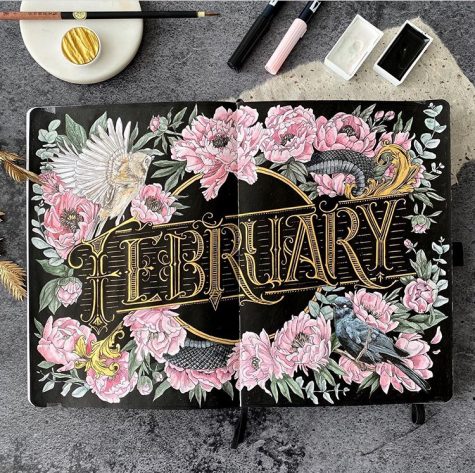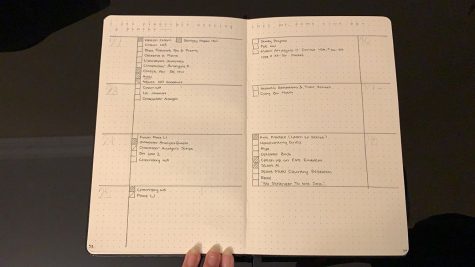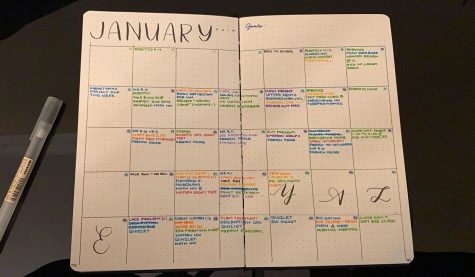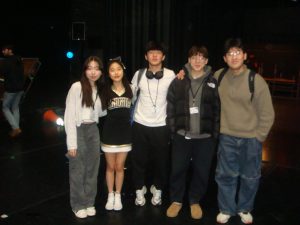The Bullet Journal: Lists, Art, and Everything In Between
February 24, 2020
Bullet Journaling is among the many methods of much-needed organisation and time-management strategies employed by BCA students. The Bullet Journal—also affectionately known as BuJo—was created by Ryder Carroll with the intention of being a minimal, efficient, and methodical organisation system. It relies on Rapid Logging, a method of recording information in bulleted lists–hence the name. On a daily basis, the Bullet Journalist would use the journal to keep a running list of tasks, events, and notes, and notate these bullets with simple markings as their statuses change. Many Bullet Journalists, in the style of Carroll, also utilise a Monthly Log and a Future Log—for outlining monthly and yearly future plans, respectively—including long-term goals, aspirations, and projects. Overall, the Bullet Journal, in Carroll’s own words, is “a mindfulness practice disguised as a productivity system,” intended to allow the users to unload the constant lists and to-dos for the future in their brains into a specialised place, so they can place more focus on the present.
Ironically, many Bullet Journalists have abandoned the minimalism at the heart of the original Bullet Journal. A few quick searches on search engines and social media for “Bullet Journal” reveal highly embellished and artistic notebooks, that look, more than anything, like self-decorated planners. While undoubtedly much more aesthetically beautiful than the original Bullet Journal, these notebooks have evolved into an almost unrecognisable form, much more centred on the artistic expression than on the intended functions of the original Bullet Journal.
Despite being an analogue system, the influence of the media extends to students’ perception of the Bullet Journal. In a survey sent to BCA students, 16% of the respondents reported that they have tried Bullet Journals in the past, but they do not use it anymore. Interestingly, when asked why they stopped, the overwhelming responses were that Bullet Journals are too time-consuming and too difficult to maintain. Many students also answered that they are too perfectionistic in journaling, using more time to set-up the journal than

Credit: Tiia (Instagram: @archaic_noctuary)
actually using it, which makes the productivity tool more a burden than a method of release. The pressure to have complex, good-looking journals comes not only from the students themselves, but also from the community, where thousands of Bullet Journalists upload their artistic, organised, and photo-perfect journals to all kinds of social media platforms, like Tumblr, YouTube, Instagram, and study websites.
However, unlike most Bullet Journalists, the most popular Bullet Journal influencers on social media are often professional artists that run their accounts as a living. Nevertheless, this does not stop their artwork from defining Bullet Journals for many people, causing unrealistic expectations in regular Bullet Journalists who have neither the time nor the need to make their Bullet Journals as elaborate and flawless as the ones created by influencers. Therefore, unable to reach their expectations, many quit Bullet Journaling altogether and fulfil the functions of a Bullet Journal with alternative methods such as regular notebooks, to-do lists, and digital calendar apps.

Credits: Anjali Anbu (Instagram @boo_studies)
Anjali Anbu, an AEDT sophomore, is among those who did not quit. For her, Bullet Journaling is now “a daily ritual,” but she has not always been consistent: last December, for example,
she barely used
her journal at all. She explains that she could not keep up with journaling due to having too many spreads in the beginning, which only served to de-motivate her because Bullet Journaling became another task that had to be done. She adds, “When there [are] too many spreads, which happens a lot with new Bullet Journal users, you get overwhelmed really quickly…you feel like you have to do all of them…and no, I just can’t be bothered.”

To fix this issue, Anjali significantly changed how she Bullet Journals. Comparing her set-up from August 2019—when she just began Bullet Journalling, to that of March 2020: “Last August, I had a mood tracker, a mini calendar, a header page, a sleep tracker, a habit tracker, a monthly calendar, weekly spreads with mini calendars, and also a book tracker…By comparison, the set-up I have for March has no cover page, a monthly calendar, and weekly spreads; I’ve taken the number of spreads I do from seven different spreads to two different spreads.”
The optimisation and simplification processes prove crucial in the continuation of Anjali’s journaling journey. “Prioritising what I need to use [the Bullet Journal] for” was why she did not stop.

She continues, “I’m pretty consistent about using it every day because it’s so simple right now…If I see myself not using a spread, I’ll just stop making the spread. I’ll stop wasting pages on it, I’ll stop leaving the blank spaces where it will be; I just cut it out until I know I will be back to using it.”
According to the survey, out of the 26% of respondents who do use Bullet Journals, about 42% said that their journals are more focused on the aesthetic aspect, while about 38% said that their journals are more focused on the functional aspect. Regarding the media’s influence on this, Anjali says, “The presence of Bullet Journals in the media right now is very focused on the art aspect: it is focused on the ‘oh, it has to look this way’, on the ‘you have cut things and glue things and colour things and draw things, otherwise it’s not good enough.’” She feels that too much emphasis on the artistic aspect can inhibit the Bullet Journal’s ability to function as a pragmatic tool, which goes against the central principles of the Bullet Journal.
However, when asked whether too much deviation from the original format means that a journal is no longer a Bullet Journal, Anjali says that she does not feel it is right to “gate-keep what is a Bullet Journal and what is not.” Besides, she says, “[a Bullet Journal] doesn’t need to look a certain way or do a certain thing to be a Bullet Journal, and that’s why there’s such a beautiful spectrum of different kinds of Bullet Journals out there.”
To Anjali, the great variety of styles in the Bullet Journal community is what makes it fantastic. Returning to Carroll’s description of Bullet Journals, the essence of Bullet Journals lies not in the physical appearance, but in that they help the users stay mindful, introspective, focused, and organised; they can, and should work in whatever way the users intend them to work.
After all, in Anjali’s words, “It’s a blank book until you start it.”






